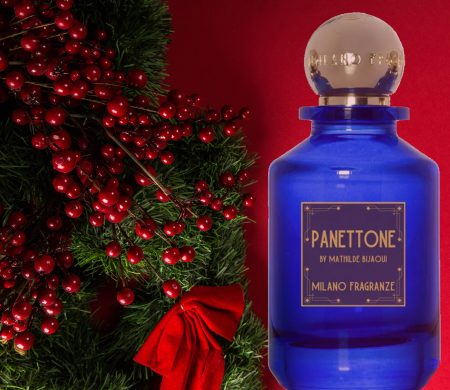
Milano Fragrance Panettone, edit by Nicoleta (Toni Cuenca via Unsplash background)
Some words have the combined effect of Pavlov’s bell mixed in with the poetic nostalgia of the first bite from a Proustian Madeleine. Can one be both hungry and nostalgic at the same time (even if you are not Italian)? You betcha! Enter Panettone, the magical cake of Christmas, and just listen to how the mere pronunciation of this word, spoken out loud, fills the air with sparkle: pah-neht-toh-neh!
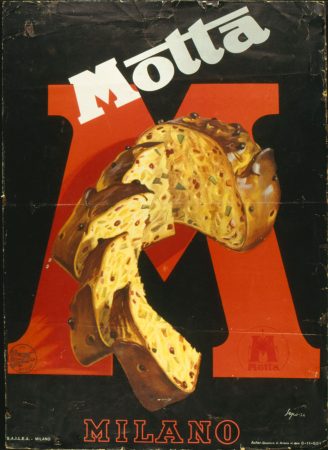
Ad for Motta bakery in Milan,1934 via poster museum dot com
In Italian “panetto” means a small loaf of cake, and by playfully adding the augmentative suffix, “-one”, changes meaning to a large loaf of cake, which reflects the size of panettone. There are many legends and stories woven around the history of panettone, including its etymology – most notably that of a holy man called Father Antonio, who was never seen without his ecclesiastical hat, as he was “very fond of his pane”. Given the similarity between the shape of the clerical hat and the name of father AnTONIo, we have the anecdotical story of “pane di toni” – panettone. The first written document that linked panettone with Christmas celebrations was in the books of Pietro Verri, an eighteen-century illuminist who referred to it as “pan de ton” (translated as luxury bread), given the price and scarcity of its precious ingredients and the intensity of labor its recipe called for.
For the origin of the Panettone recipe, we have to go very far back in history, to the ancient Romans who invented a special rising-dough bread that was sweetened with honey and usually used in religious ceremonies. From here on, we have a myriad of myths and tales to enjoy. The most famous one involves the Duke of Milano, Ludovico Sforza, whose chef accidentally burned the dessert for his sumptuous Christmas banquet. A kitchen boy named Toni, suggested serving a desert that he had made for himself earlier, with what he had found lying around in the pantry: flour, butter, eggs, raisins, and citrus peel. It is said that the Duke tasted it, and overjoyed, asked what was the name of this new and scrumptious dessert. The answer came in the purest Milanese accent “L’è ‘l pan del Toni!” translated as “it’s Toni’s bread”.

Alessandro Brun Milano Fragranze and co-founder of Masque Milano
All the stories about the history of panettone have one thing in common: the place of its origin – Milano. No wonder then, that creative director Alessandro Brun of Milano Fragranze (also the co-founder of Masque Milano) chose Panettone as the next “pin” in his highly personal scented map of Milano, which he recreated, as a love manifesto, for his beloved city: “I was born and raised in Milan, and I developed an incredible affection for this city, to the point of feeling so lucky just for the fact of having been born here. This city gave me so much, having a significant contribution of shaping what I am today. For years I have been thinking that one day I would have developed something to let the world know how beautiful this city is and how much I love it. That day has finally arrived.”
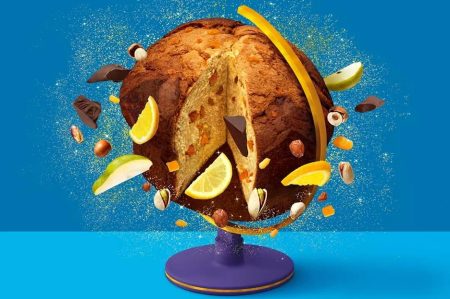
Bauli commercial, via Facebook official page
My love story with panettone comes from the aspirational Bauli commercials, that were playing on hi rotation on Italian TV stations, in the 90s (just having a wide-eye nostalgia moment about programs like Non è la RAI) and I remember asking my grandmother to replace the cocoa and nuts from our traditional festive sweet bread “cozonac” or “kozunak” (a dish we share with our fellow eastern Europeans and Greeks) with dried fruits, and to make it more like the Bauli dome-shaped cakes I saw on TV.
If you have never tasted a REAL handmade Panettone (oh, my heart sighs for you), let me try to describe its majestic beauty. It’s a hefty cake, weighing around 2,2 pounds, and about 8 inches high with a long and intricate cooking process (it is said that cooking one is a real labor of love) that involves curing the dough, that has to slowly ferment many hours, and the special proofing process that can take several days. The classical ingredients are flour, eggs, butter, yeast, dry raisins, candied oranges, and lemon zest. Varieties include mascarpone cream, chocolate, hazelnuts, pistachio, limoncello, and even ice cream or pumpkin flavors. I am a “panettone purist” and I declare the classical taste to be the best and most ceremonial. Nothing can compare to the joy of having the wedge of your first slice, on your plate, accompanied maybe by an extra hand of rum-soaked raisins next to it, and raising a glass of red wine.
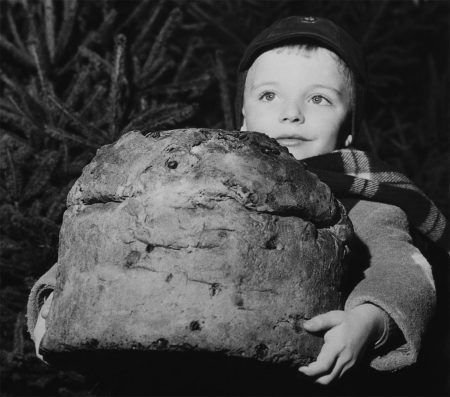
A child carrying a panettone in Milan, 20 December 1958, via history today
Milano Fragranze Panettone reminds me of a snow globe that encapsulates a perfect freeze-frame memory of Christmas. Entering the house, back from the freezing cold, cheeks red from playing outside all day, until the yellow lights of the streetlamps signaled you to come back. Close the door, holding your breath and praying everyone has been way too busy with Christmas preparations to notice that you have been out all day and have returned so late, so you try to be as silent as humanly possible, while you take off the winter coat and your snow-filled boots.
The magic transformation of the house suddenly catches you off guard and you just stay there, like a small wide-eyed deer in Christmas lights, in the hallway, basking in the flickering tree, decorated in your absence, and the smell of orange and mandarin peels strategically placed on radiators, to slowly release their dry sweet aroma into the air. You sigh with pleasure – a little too loudly – and the inevitable happens. Nonna’s voice, alarmingly rising in intensity and echoing in the hallway from the kitchen is approaching! If multitasking would be an art, it is raised to superhuman prowess by a grandmother caught in the midst of preparing a celebratory dinner. If you would think there would be no time to scold a naughty grandson, well, think again! There is always time for that.
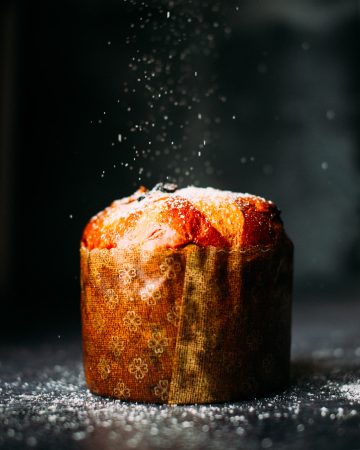
via unsplash
Like a guilty kitten, tail between your legs, you follow her to the kitchen, where she has already begun to prepare the ginger root tea for your sore throat and runny nose, while with another hand she looks for the herbaceous healing rub, that she uses to heal the microscopical small scratches that you have from making snowballs all day. You hear, for the hundredth time, the story of San Biagio, the protector from all winter ills. On the feast day held in his honor, on February the third, people (especially kids) eat a slice of dried-out panettone that they saved from Christmas, to cure and protect from sore throats. Nonna complains every Christmas, that she should save a whole cake for the saint’s day, not just a slice, for you being as naughty as you are.
You drink your hot tea in remorseful silence, listening to the small radio hung on the wall, playing carols mixed with static. It’s a deliciously forbidden late hour of the evening, you are still up, and have begun to help sort all the ingredients and ceremoniously place them in the dough that has been fermenting in the bowl covered by the embroidered white cloth, that Nonna uses only when she cooks something really special. Your little hands sort through the dried fruits and the rum-soaked raisins, slipping an occasional piece in your moth and solemnly chewing it. Before placing it in the oven, she makes the sign of the cross on top of the cake, as a good omen for the coming year. You feel the tight grip of her arms around you, pulling you in the warmest, safest hug. It’s home. It’s Christmas.

Mathilde Bijaoui via the perfumer
Milano Fragranze Panettone smells like a capsule-scented memory of a perfect Christmas. Candied fruits, bitter orange, this smells like slicing through the perfect wedge of fresh Panettone. It smells yellow, festive, with a buttery floral touch and a doughy quality that almost has a bounce to it – imagine pinching the softness of the cake and watching it slowly return to its original shape. A must-try if you are a gourmand lover. Or someone who wants a “taste” of Milan.
Read Michelyn’s interview with Mathilde Bijaoui here, plus revisit reviews of her perfumes: , État Libre d’Orange Spice Must Flow, Malaise of the 1970s, Bijou Romantiqueand Like This, Jo Malone Scarlet Poppy, and Jasmin Sambac and Marigold Cologne
Notes: Bitter Orange E.O., Mandarin E.O., Ginger E.O., Carrot Seeds E.O. Davana E.O., Rum Pure Jungle Essence TM, Everlasting Flower Abs., Tagete Seeds E.O., Vanilla Abs., Vinyl Gaiacol Natural
ÇaFleureBon Video Content Journalist Contributor Steven Gavrielatos of Redolessence interviews Alessandro Brun about MILANO Fragranze via ZOOM. Perfume reviews of Basilica, Galleria, Brera, La prima
Nicoleta Tomsa, Senior Editor
Disclosure: samples kindly provided by Milano Fragranze, opinions are my own
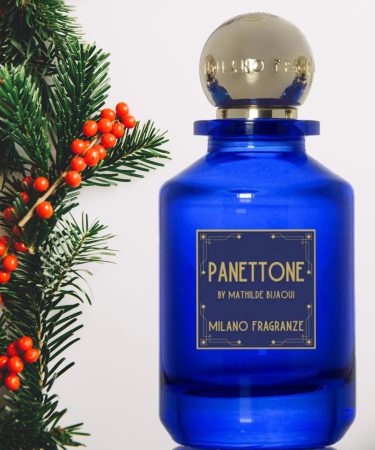
Milano Fragranze Panettone with digital effects by Nicoleta
Thanks to the generosity of Milano Fragranze, we have a100 ml bottle of Panettone for one registered reader in the USA, UK and EU. You must register or your entry will not count. To be eligible, please leave a comment saying what sparks your interest based on Nicoleta’s review of Milano Fragranze Panettone and where you live. Draw closes 12/23/2021
PLEASE NOTE THAT OUR NEW INSTAGRAM IS @cafleurebonoffical
Follow us on Instagram @cafleurebonofficial @nicoleta.tomsa @milanofragranze @mathilde.bijaoui.perfumer
This is our Privacy and Draw Rules Policy
We announce the winners only on our site and on our Facebook page, so like Çafleurebon and use our blog feed… or your dream prize will be just spilled perfume
Like our Facebook page: Çafleurebon and use our blog feed for new updates and articles
